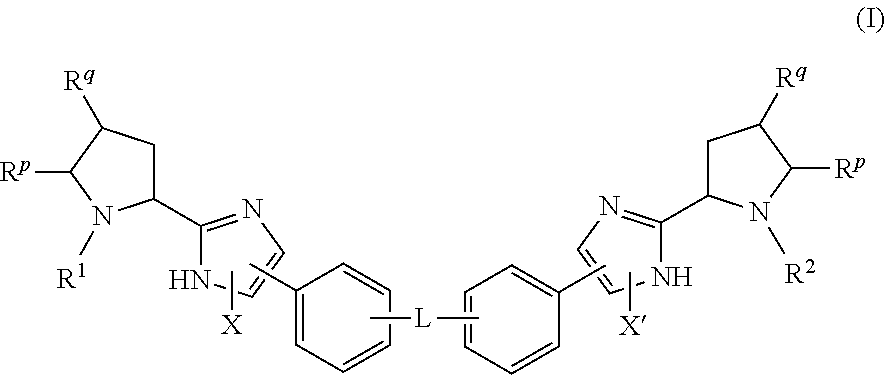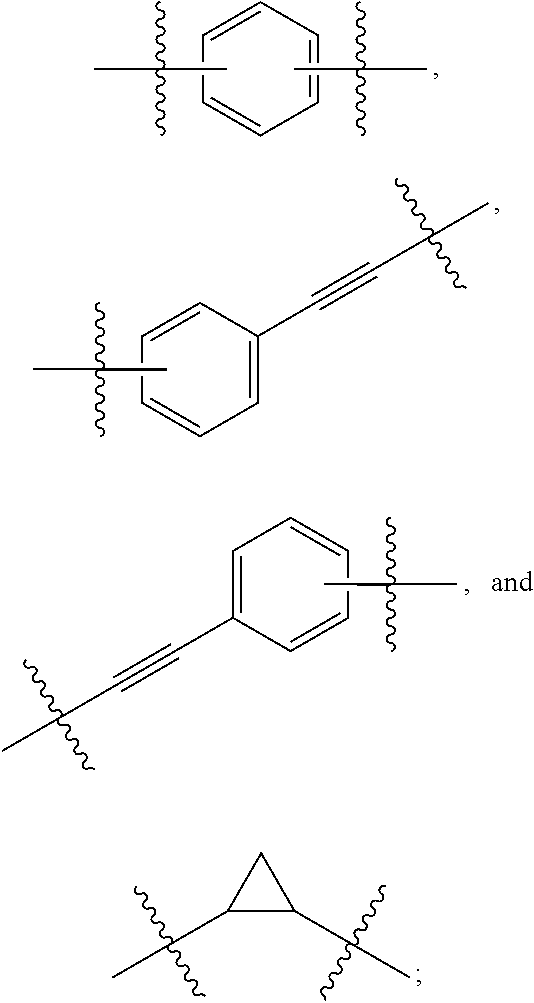Hepatitis C Virus Inhibitors
a technology of hepatitis c virus and inhibitors, applied in the field of antiviral compounds, can solve the problems of non-optimal success rate in achieving sustained viral response, numerous side effects, and considerable heterogeneity in the nucleotide and encoded amino acid sequen
- Summary
- Abstract
- Description
- Claims
- Application Information
AI Technical Summary
Problems solved by technology
Method used
Image
Examples
examples
Example OL-1
[0300]
Example OL-1, Step a
[0301]
[0302]4,4′-Oxybis-(benzoic acid) dimethyl ester (1.5 g, 5.24 mmol) was added to a solution of chloroiodomethane (3.05 mL, 41.92 mmol) in tetrahydrofuran (50 mL) and the resulting solution was cooled to −78° C. A 1.8M solution of LDA (29 mL, 52 mmol) in tetrahydrofuran was added dropwise and the resulting brown suspension was stirred at −78° C. for 15 min. A solution of glacial acetic acid in tetrahydrofuran (10 mL in 50 mL) was then added slowly and the brown mixture was stirred at −78° C. for 10 min. before allowing it to reach room temperature. The mixture was taken up in ethyl acetate and brine (1:1, 50 mL) and the organic layer was then separated, washed with a sat. solution of sodium bicarbonate and brine, dried (MgSO4), filtered, and concentrated in vacuo. The residue was submitted to flash chromatography (silica gel; 15% ethyl acetate / hexanes) to provide OL-1a as a pale brown solid (0.6 g). 1H NMR (500 MHz, DMSO-d6) δ ppm 5.17 (s, 4...
example ol-1
[0313]HATU (52 mg, 0.137 mmol) was added to a mixture of OL-1e (35 mg, 0.06 mmol), diisopropylethylamine (58 μL, 0.33 mmol) and Cap-1 (22 mg, 0.12 mmol) in dimethylformamide (3 mL), and the resulting mixture was stirred at ambient for 3 h. The volatile component was removed in vacuo, and the residue was purified by a reverse phase HPLC system (water / methanol / TFA) to provide the TFA salt of Example OL-1 as an off-white solid (32 mg). 1H NMR (500 MHz, DMSO-D6) δ ppm 1.82-1.93 (m, 2H), 1.94-2.08 (m, 4H), 2.14-2.24 (m, 2H), 2.29-2.40 (m, 4H), 2.83 (s, 4H), 2.97-3.07 (m, 4H), 3.97 (t, J=8.24 Hz, 2H), 4.89-5.20 (m, 2H), 5.34-5.73 (m, 2H), 7.00-7.22 (m, 6H), 7.49-7.64 (m, 9H), 7.70-7.89 (m, 5H), 10.20 (br.s, 2H). LC (Cond. 1): RT=2.48 min; LRMS: Anal. Calcd. for (M+H)+C46H51N8O3 763.41; found: 763.56; HRMS: Anal. Calcd. for (M+H)+C46H51N8O3 763.4084; found: 763.4109.
examples ol-2
and OL-3
[0314]
[0315]Examples OL-2 and OL-3 were prepared as TFA salts by substituting the respective acids for Cap-1 using the same method described for Example OL-1.
ExampleRT (LC-Cond.); MS dataOL-2RT = 2.92 min. LC (Cond. 2); LCMS: Anal. Calcd. For (M + H)+ C42H41N6O5 709.31; Found: 709.41; HRMS: Anal. Calcd. for: C42H41N6O5 709.3138; Found: 709.3147 (M + H)+OL-3RT = 3.65 min). LC (Cond. 2); LCMS: Anal. Calcd. for (M + H)+ C46H47N8O7 823.35; Found: 823.66; HRMS: Anal. Calcd. for (M + H)+ C46H47N8O7 823.3568; Found: 823.3574
Example OL-4
[0316]
Example OL-4, Step a
[0317]
[0318]Methyl 3-bromobenzoate (5 g, 23.2 mmol), methyl 4-hydroxybenzoate (5.3 g, 34.87 mmol), cesium carbonate (15.12 g, 46.4 mmol), copper (I) iodide (0.44 g, 2.32 mmol) and N,N-dimethyl hydrochloride (0.97 g, 6.96 mmol) were combined in dioxane (100 ml) in a sealed tube and the resulting mixture was heated to 90° C. for 15 h. The solvent was removed under reduced pressure and the residue was taken up in ethyl acetate / ...
PUM
| Property | Measurement | Unit |
|---|---|---|
| particle size | aaaaa | aaaaa |
| pH | aaaaa | aaaaa |
| temperature | aaaaa | aaaaa |
Abstract
Description
Claims
Application Information
 Login to View More
Login to View More - R&D
- Intellectual Property
- Life Sciences
- Materials
- Tech Scout
- Unparalleled Data Quality
- Higher Quality Content
- 60% Fewer Hallucinations
Browse by: Latest US Patents, China's latest patents, Technical Efficacy Thesaurus, Application Domain, Technology Topic, Popular Technical Reports.
© 2025 PatSnap. All rights reserved.Legal|Privacy policy|Modern Slavery Act Transparency Statement|Sitemap|About US| Contact US: help@patsnap.com



